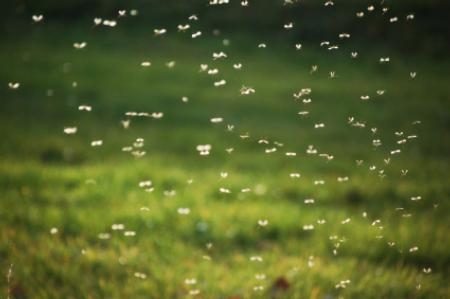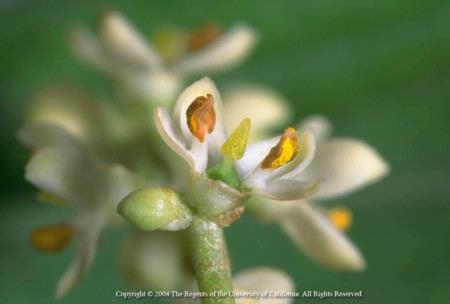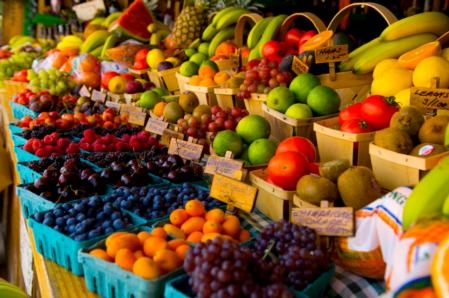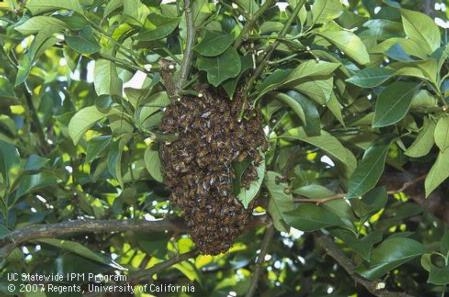- Author: Annemiek Schilder
In this weekly blog, Dr. Annemiek Schilder, Director, UCCE Ventura County and Hansen Agricultural Research and Extension Center, shares her observations about the natural world across the seasons. As she says:
"Gently observing your surroundings with curiosity will teach you some amazing things. There are so many fascinating things happening under our noses, only wanting for an observant eye."
The flowering spikes of the octopus agave (Agave vilmoriniana), currently in bloom in the Master Gardener Demonstration Garden at HAREC in Santa Paula, are seriously impressive at more than 12 feet tall. Octopus agave is a drought-tolerant plant native to the Mexican desert where it grows on rocky ground. The gray-green smooth, twisting leaves with flexible spikes at the tips give the plant an octopus-like appearance. Like other agaves, it is monocarpic, flowering only once in its life before it dies.
Agaves belong to the family Asparagaceae and are therefore related to asparagus. Indeed, young flower spikes may resemble giant asparagus spears. Flowering usually occurs between 6 and 25 years of age. The plant invests all of its energy into producing a spectacular flower display as its last hurrah. The copious small yellow flowers start opening at the bottom of the spike, moving upwards in waves. Flowering may occur over a period of 4 to 8 weeks.
Agave flowers are a magnet for pollinating insects and hummingbirds. However, in their native habitat, nectar-feeding bats, such as the lesser long-nosed bat and the Mexican long-tongued bat, play an important role in agave flower pollination. This may also explain the height of the flower spikes. Bats pollinate at night and are critical for seedset. In the absence of these specialized bats, fewer than 5% of the flowers may produce seed. Commercial cultivation of agave for tequila, which involves cutting off flower stalks, as well as pesticides and habitat destruction have been put forward as reasons for the current endangered status of some of these bat species in Mexico.
In addition to seeds, plantlets called “bulbils” may be produced in large numbers on spent flower stalks. These bulbils are exact clones of the mother plant and will root readily when planted in soil. While clonal reproduction is a good short-term strategy for plant survival, it does limit genetic diversity which makes the species less adaptable to environmental changes in the long term.
- Author: Chris M. Webb
Recently our office has received many calls about bee swarms. These calls are typical at this time of year. Each swarm can contain 5,000 to 20,000 bees.
Understandably bee swarms can cause uneasiness to residents unfamiliar with honey bees. While the swarms might seem frightening, the common honey bee is extremely docile. Unless they feel threatened they are unlikely to react defensively.
Swarming bees are in search of a new home. Honey bees prefer dark cavities with an easily defendable entrance at least 9 feet from the ground. Hollowed out trees are ideal sites, but other favored sites include: inside walls of houses, in or around chimneys, in outbuildings, fences, shrubs, water meters, utility boxes, barbecue grills, or under decks.
To learn more about honey bee swarms and hives, please see UC’s Removing Honey Bee Swarms and Established Hives.
Topics include:
- What is a bee swarm?
- Damage
- Swarm clusters
- Preventing establishment of a colony in your home
- Removing established colonies from your home
- Preventing future invasions
- Finding professionals to assist with colony extractions
- Author: Chris M. Webb
UC IPM (Integrated Pest Management) has a collection of resources to help educate the public and water treatment professionals about mosquitoes. Some species of mosquitoes found in California have the potential to transmit microorganisms that can cause disease to people, pets, and livestock.
While mosquitoes are best managed on an area-wide basis by public agencies organized specifically for this purpose, the combined actions of individuals can greatly improve larger mosquito control efforts. And because some areas of our state do not have organized public mosquito management programs, the individual actions of residents are all the more important.
Main mosquito subjects found at UC IPM are:
- Mosquitoes Pest Notes
- Mosquitoes Quick Tip
- Managing Mosquitoes on the Farm
- Managing Mosquitoes in Surface-Flow Constructed Treatment Wetlands
- Managing Mosquitoes in Stormwater Treatment Devices
- West Nile Virus and related mosquito information and links
The Mosquitoes Quick Tip resource is available in Spanish.

- Author: Chris M. Webb
California agricultural producers and consumers rely on wild bee species to pollinate crops. Wild bees pollinate more than one third of California’s pollinator-dependent crops. These crops are currently estimated to be worth $11.7 billion annually. Many of these bees live in neighboring livestock rangelands, and provide diversification vital to sustaining our food supply.
Researchers have found that in addition to the economic benefits of pollination, animal pollinators provide up to 40 percent of some essential vitamins, minerals, and dietary lipids provided by fruits and vegetables.
Please see UC Berkeley’s Native Bee Habitats Key to Farming, Conservation, Nutrition for details.
Preserving and expanding pollinator habitats throughout our communities will is beneficial for all. The Pollinator Partnership is an incredible resource to help us accomplish this important goal.

- Author: Chris M. Webb
California agricultural producers and consumers rely on wild bee species to pollinate crops. Wild bees pollinate more than one third of California’s pollinator-dependent crops. These crops are currently estimated to be worth $11.7 billion annually. Many of these bees live in neighboring livestock rangelands, and provide diversification vital sustaining our food supply.
Researchers have found that in addition to the economic benefits of pollination, animal pollinators provide up to 40 percent of some essential vitamins, minerals, and dietary lipids provided by fruits and vegetables.
Please see UC Berkeley’s Native Bee Habitats Key to Farming, Conservation, Nutrition for details.
Preserving and expanding pollinator habitats throughout our communities will is beneficial for all. The Pollinator Partnership is an incredible resource to help us accomplish this important goal.






